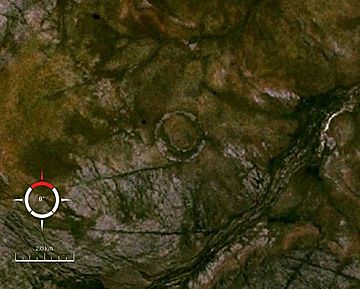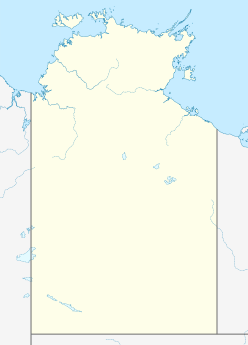Liverpool crater facts for kids
| Yingundji | |

Landsat image of the Liverpool crater (circular feature in centre); screen capture from NASA World Wind
|
|
| Impact crater/structure | |
|---|---|
| Confidence | Confirmed |
| Diameter | 1.6 km (0.99 mi) |
| Age | 150 ± 70 Ma Mesozoic |
| Exposed | Yes |
| Drilled | No |
| Location | |
| Location | McArthur Basin, Arnhem Land |
| Coordinates | 12°23′45″S 134°2′50″E / 12.39583°S 134.04722°E |
| Country | Australia |
| State | Northern Territory |
The Liverpool crater is a special place in Arnhem Land, Northern Territory, Australia. It was made when a meteorite crashed into Earth a very long time ago. This crater is named after the nearby Liverpool River. It's quite far away and not easy to visit. The crater has a slightly raised, almost round edge. This edge is about 1.6 kilometers (1 mile) wide. Scientists first saw the crater in the 1960s. They thought it might be from an impact, but they confirmed it in 1970 after more study.
What is the Liverpool Crater?
The Liverpool crater sits in flat sandstone rock. This rock is very old, from a time called the Palaeoproterozoic era. The meteorite impact broke and shattered this sandstone. This broken rock formed the raised edge of the crater.
Inside the center of the crater, you can see flat sandstone that is not broken. This rock must have been laid down after the meteorite hit. Because the crater looks so well-preserved, scientists think it was covered by younger rocks soon after the impact. Most of these younger rocks have now worn away. However, some still remain in the crater's middle.
Scientists first thought the rock filling the crater was from the Cretaceous period. This would have made the crater about 150 million years old. But newer studies suggest the rock is much older. It is likely from the Neoproterozoic era, which was about 1000 to 543 million years ago. This means the crater itself is probably much older than first thought.
How do we know it's an impact crater?
No pieces of the actual meteorite have been found at the site. This is normal because the crater is so old. Any meteorite fragments would have worn away over millions of years.
However, there is strong evidence that it was made by an impact. Scientists look at the way the rocks are structured in the crater. They also found something called shocked quartz. This is a type of quartz that has been changed by extreme pressure. This kind of pressure only happens during a very powerful event, like a meteorite impact.
The crater is not a perfect circle. It is about 6% wider from the northeast to the southwest. The inside parts of the crater are also uneven. This suggests that the meteorite hit the Earth at an angle, coming from the southwest.
Aboriginal Significance
The Aboriginal people who live in Western Arnhem Land have their own name for the Liverpool crater. They call it Yingundji. They describe it as the nest of a giant catfish.
This story is supported by ancient rock art. There are pictures, called pictographs, of giant catfish on the walls of a rock shelter. This shelter is located right inside the crater.


